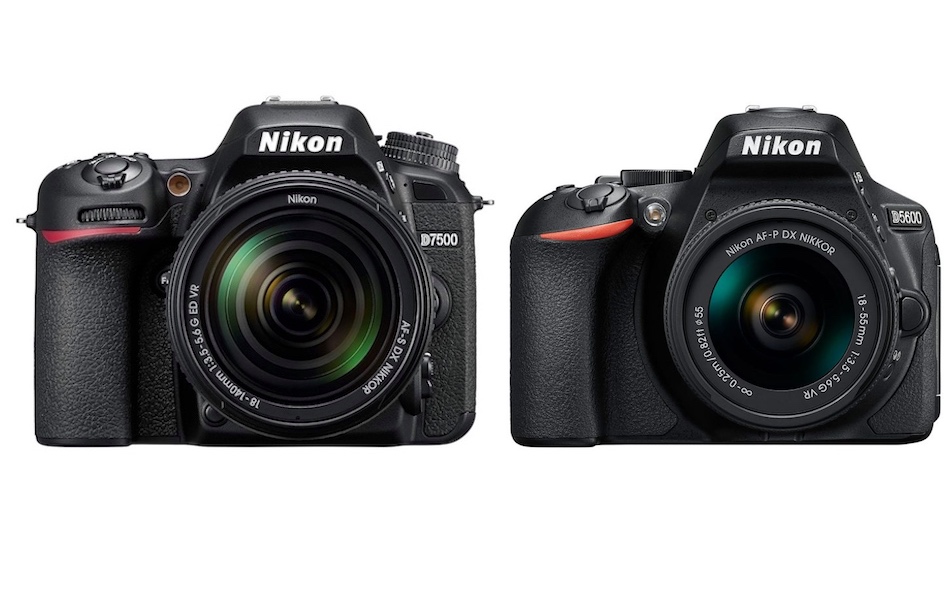Nikon D7500 vs D5600 – Comparison
Here is a quick comparison and review for the Nikon D7500 vs D5600 DSLR cameras. Below you can find the differences of these mid-range cameras with APS-c sized image sensors.
The first difference between these two cameras is the sensor size. Nikon D7500 uses the same 20.9MP sensor with no optical low pass filter as the D500, as well as its Expeed 5 image processor. This new processor is 30% faster than the Expeed 4 processor in the D5600, a speed advantage that gives the D7500 for the features like burst speed, buffer depth, video capability and native ISO sensitivity.
Let’s have a brief look at the main features of Nikon D7500 vs D5600. So what may be the main differences when consider their specs list?
Join Nikon D7500 Facebook Group
Differences between Nikon D7500 vs D5600 DSLR Cameras
If you’re trying to decide which one to buy as your first camera, here are the differences of Nikon D7500 vs D5600 cameras. Our comparison table below covers all the important specifications of each camera.
Nikon D7500 vs D5600 Comparison Table
| Features | Nikon D7500 | Nikon D5600 |
|---|---|---|
| Sensor resolution | 20.9MP APS-C CMOS | 24.2 MP APS-C CMOS |
| AA Filter | No | No |
| Max Image Resolution | 5568 x 3712 | 6000 x 4000 |
| Image Processor | EXPEED 5 | EXPEED 4 |
| ISO | ISO 50 (exp)/ISO 100 – ISO 51200/ISO 1,640,000 (exp) | 100 – 25,600 Not Expandable |
| AF System | Multi-CAM 3500FX II 51 point AF (15 cross-type) |
Multi-CAM 4800DX 39 point AF (9 cross-type) |
| LCD | 3.2″ / 8 cm Titling touchscreen 921,600 dots | 3.2″ / 8 cm Titling touchscreen 921,600 dots |
| Viewfinder | Optical 100% coverage 0.94x/0.63 x |
Optical (Pentaprism) 0.82x magnification 95% coverage |
| Shutter Speed | 30-1/8000 sec | 30-1/4000 sec |
| Flash X Sync Speed | 1/250 sec | 1/200 sec |
| Burst Speed | 8fps | 5fps |
| Exposure Compensation | ±5 (at 1/3 EV, 1/2 EV steps) | ±5 (at 1/3 EV, 1/2 EV steps) |
| Video Recording (max. res) |
H.264 QuickTime MOV 4K UHD/30p, 25p, 24p | 1920 x 1080 (60, 50, 25, 24 fps) |
| Time Lapse | Yes | Yes |
| Jpeg Buffer Size | 100 | 100 |
| RAW Buffer Size | 50 | 12 |
| Mic Input | Yes | Yes |
| Headphone Jack | Yes | No |
| Wireless Connectivity | Wi-Fi with Snapbridge | Wi-Fi + NFC with Snapbridge |
| USB Charge | Yes | Yes |
| Environmentally Sealed | Yes | No |
| Battery Life | 950 shots | 820 shots |
| Dimensions | 136 x 104 x 73 mm | 124 x 97 x 70 mm |
| Weight | 640 g | 415 g |
| Price | $1,250 | $696 |
Conclusion
As Nikon D5600 is a mid to entry-level DSLR that costs you near half the price of Nikon D7500. It is clearly visible from the table above that Nikon D7500 is a clear winner with class leading specs. If you want speed, ISO range and 4K video features it would be wise to go with the D7500, other than that for beginners we advice the budget-friendly D5600.









